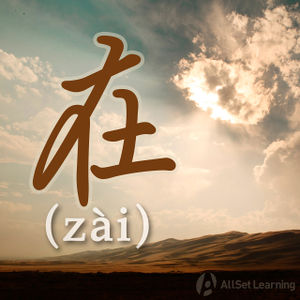Difference between revisions of "Expressing actions in progress with "zai""
m |
|||
| Line 23: | Line 23: | ||
* 她 <em>在</em> 看 书。<span class="trans">She is reading.</span> | * 她 <em>在</em> 看 书。<span class="trans">She is reading.</span> | ||
| − | * 我们 <em>正在</em> 吃 饭。<span class="trans">We | + | * 我们 <em>正在</em> 吃 饭。<span class="trans">We're eating right now.</span> |
| − | * 我 <em>在</em> 喝 啤酒。<span class="trans">I | + | * 我 <em>在</em> 喝 啤酒。<span class="trans">I'm drinking beer.</span> |
* 他 现在 <em>在</em> 开会,没 有 时间 见 你。<span class="trans">He is currently in a meeting, he doesn't have time to see you.</span> | * 他 现在 <em>在</em> 开会,没 有 时间 见 你。<span class="trans">He is currently in a meeting, he doesn't have time to see you.</span> | ||
* 我 <em>在</em> 上网。<span class="trans">I am surfing the internet.</span> | * 我 <em>在</em> 上网。<span class="trans">I am surfing the internet.</span> | ||
| − | * 我 现在 <em>在</em> 上班。<span class="trans">I am | + | * 我 现在 <em>在</em> 上班。<span class="trans">I am working now.</span> |
| − | * 我们 <em>正在</em> 上课,请 你 等 一会儿。<span class="trans">We are | + | * 我们 <em>正在</em> 上课,请 你 等 一会儿。<span class="trans">We are in class right now; please wait a moment.</span> |
| − | * 我 妈妈 <em>正在</em> 做 饭。<span class="trans">My mom is | + | * 我 妈妈 <em>正在</em> 做 饭。<span class="trans">My mom is cooking right now.</span> |
| − | * 十 点 的时候,她 <em>正在</em> 看 电影。<span class="trans"> | + | * 十 点 的时候,她 <em>正在</em> 看 电影。<span class="trans">At ten o'clock, she was watching a movie.</span> |
| − | * 你 给 我 | + | * 你 给 我 打 电话 的时候,我 <em>正在</em> 跟 朋友 喝酒。<span class="trans">When you called me, I was drinking with friends.</span> |
</div> | </div> | ||
| − | There is no need to worry too much about when to use 在 (zài) or 正在 (zhèngzài), since they basically mean the same thing. 正在 (zhèngzài) usually shows that the action is in progress. 在+ | + | There is no need to worry too much about when to use 在 (zài) or 正在 (zhèngzài), since they basically mean the same thing. 正在 (zhèngzài) usually shows that the action is in progress. "在 + Verb" is more commonly used than "正在 + Verb," but both are okay to use. As mentioned, the only small difference is that 正在 (zhèngzài) emphasizes that the action is happening ''right now''. |
==See also== | ==See also== | ||
Revision as of 02:17, 9 October 2014
-
Level
-
Similar to
-
Used for
-
Keywords
在 (zài) and 正在 (zhèngzài) can be used as auxiliary verbs to express that an action is ongoing or in progress. This is often the equivalent of present continuous in English, which is how we express that an activity is happening now. You can use 正在 (zhèngzài) to put a little more emphasis on the action as in progress right now.
Structure
Subject + 在 + Verb + Object
or
Subject + 正在 + Verb + Object
Examples
- 她 在 看 书。She is reading.
- 我们 正在 吃 饭。We're eating right now.
- 我 在 喝 啤酒。I'm drinking beer.
- 他 现在 在 开会,没 有 时间 见 你。He is currently in a meeting, he doesn't have time to see you.
- 我 在 上网。I am surfing the internet.
- 我 现在 在 上班。I am working now.
- 我们 正在 上课,请 你 等 一会儿。We are in class right now; please wait a moment.
- 我 妈妈 正在 做 饭。My mom is cooking right now.
- 十 点 的时候,她 正在 看 电影。At ten o'clock, she was watching a movie.
- 你 给 我 打 电话 的时候,我 正在 跟 朋友 喝酒。When you called me, I was drinking with friends.
There is no need to worry too much about when to use 在 (zài) or 正在 (zhèngzài), since they basically mean the same thing. 正在 (zhèngzài) usually shows that the action is in progress. "在 + Verb" is more commonly used than "正在 + Verb," but both are okay to use. As mentioned, the only small difference is that 正在 (zhèngzài) emphasizes that the action is happening right now.
See also
- Aspect particle "zhe"
- Expressing actions in progress (full form) (more advanced usage)
Sources and further reading
Books
- Basic Patterns of Chinese Grammar (pp. 41-2) →buy
- Chinese: An Essential Grammar, Second Edition (pp. 60-1) →buy
- Integrated Chinese: Level 1, Part 1 (3rd ed) (pp. 209-10) →buy
- New Practical Chinese Reader 2 (新实用汉语课本2) (pp. 218-9) →buy



